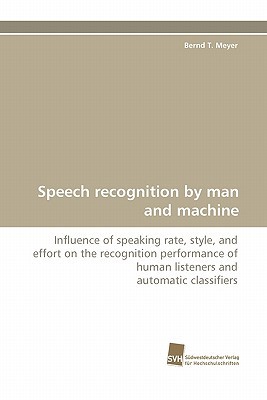
- We will send in 10–14 business days.
- Author: Bernd T Meyer
- Publisher: Sudwestdeutscher Verlag Fur Hochschulschriften AG
- ISBN-10: 3838121554
- ISBN-13: 9783838121550
- Format: 15.2 x 22.9 x 0.8 cm, softcover
- Language: English
- SAVE -10% with code: EXTRA
Reviews
Description
While human listeners have little problems in dealing with the strong variation in spoken language, the same cannot be said about automatic speech recognition (ASR). This work compares recognition performance of man and machine with the aim of learning from the distinct errors between these two. Based on the differences, the signal processing mechanisms are analyzed that are suitable to increase the robustness of ASR. The comparison focuses on the influence of intrinsic variation of speech, i.e., changes in speaking rate, effort and style, as well as dialect and accent. The outcome of the experiments suggests that the processing of temporal cues in ASR bears room for improvement. Therefore, spectro-temporal features are employed as input to ASR systems, which results in an increase of recognition performance for varying speaking effort and speaking style compared to standard features. This documents the usefulness of spectro-temporal and temporal information for automatic recognizers.
EXTRA 10 % discount with code: EXTRA
The promotion ends in 20d.08:16:22
The discount code is valid when purchasing from 10 €. Discounts do not stack.
- Author: Bernd T Meyer
- Publisher: Sudwestdeutscher Verlag Fur Hochschulschriften AG
- ISBN-10: 3838121554
- ISBN-13: 9783838121550
- Format: 15.2 x 22.9 x 0.8 cm, softcover
- Language: English English
While human listeners have little problems in dealing with the strong variation in spoken language, the same cannot be said about automatic speech recognition (ASR). This work compares recognition performance of man and machine with the aim of learning from the distinct errors between these two. Based on the differences, the signal processing mechanisms are analyzed that are suitable to increase the robustness of ASR. The comparison focuses on the influence of intrinsic variation of speech, i.e., changes in speaking rate, effort and style, as well as dialect and accent. The outcome of the experiments suggests that the processing of temporal cues in ASR bears room for improvement. Therefore, spectro-temporal features are employed as input to ASR systems, which results in an increase of recognition performance for varying speaking effort and speaking style compared to standard features. This documents the usefulness of spectro-temporal and temporal information for automatic recognizers.


Reviews